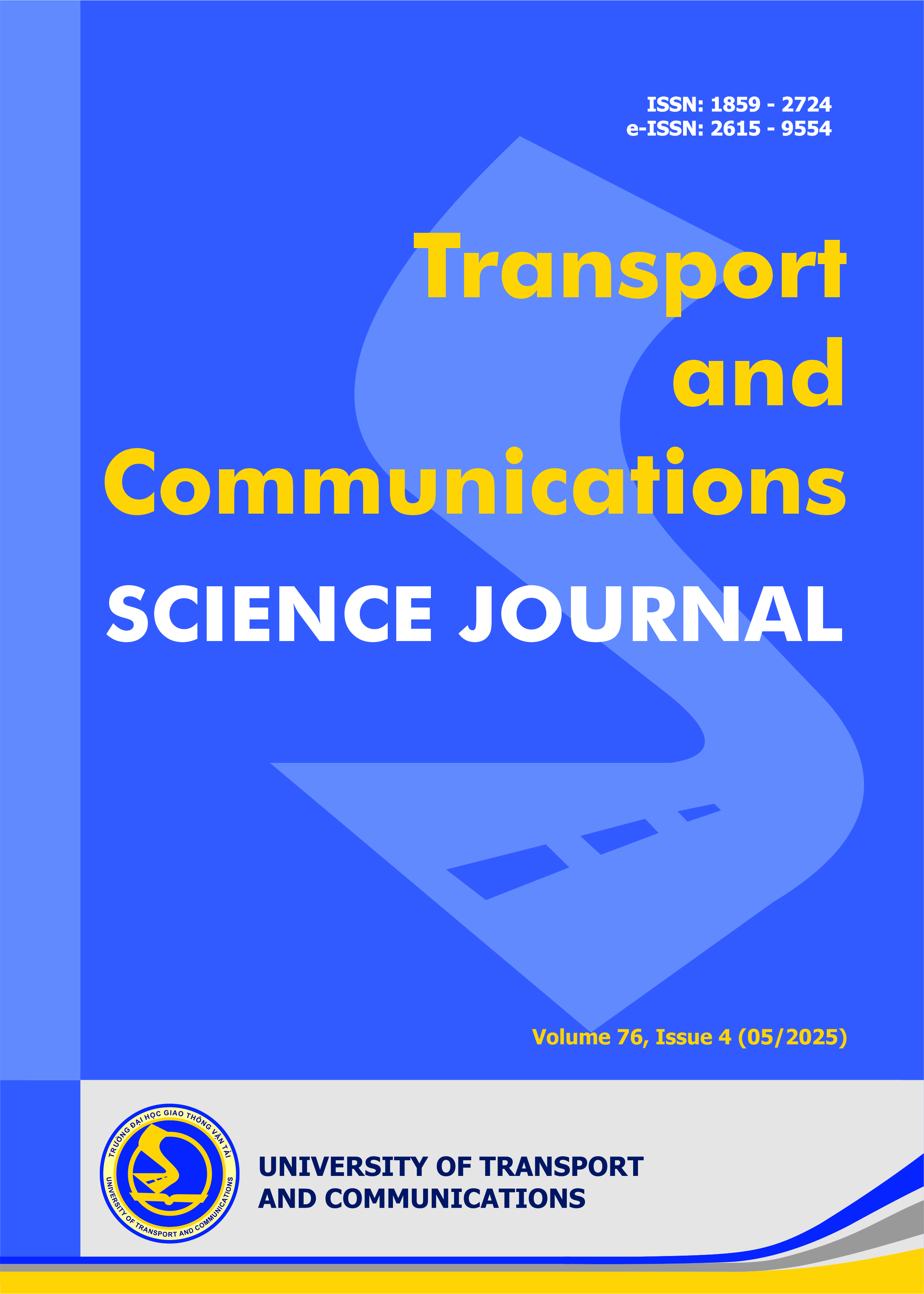Trang: 447-460 Phan Nguyen Hoai Nam, Nguyen Thi Thuy DungTóm tắtPublic transport is essential for urban mobility, yet differences in cost efficiency and service accessibility create challenges across city zones. This study examines how these factors influence public transport choices in Hanoi, considering variations across different urban areas. The analysis is based on seven key criteria: cost savings, time efficiency, convenience, safety, accessibility, reliability, and environmental awareness, providing a comprehensive understanding of regional transport preferences and economic implications. Findings indicate significant regional variations in cost savings. In urban cores, savings are limited (0%–50%) due to short travel distances and private vehicle convenience. In expanding areas, savings rise (25%–75%) as public transport becomes a cost-effective alternative for longer commutes. In peripheral and rural areas, over 50% of residents benefit from high savings, given their reliance on long-distance buses. AHP results highlight distinct priorities. Cost is the primary factor in rural areas, while accessibility drives urban core decisions due to dense transport networks. In expanding zones, time efficiency is the top concern, making metro systems the preferred choice. Notably, environmental awareness ranks lowest across all regions. The study recommends strategies aligned with circular economy principles, focusing on system optimization rather than infrastructure expansion. Solutions include smart traffic management, multimodal integration, and sustainable maintenance, offering actionable insights for Hanoi’s public transport development
Trang: 461-473 Bui Van Hung, Vu Minh Phap, Le Quang Sang, Vu Duy Duc, Nguyen Quang HoaTóm tắtThe design of the wind turbine blades has a significant impact on the operation of the wind turbine. Therefore, the cross-sectional structure of the airfoil needs to be simulated by specialized software to evaluate the impact on the performance of the wind turbine, especially in the low wind speed region. This paper studies the aerodynamic characteristics such as lift coefficient (CL), drag coefficient (CD) and ratio (CL/CD) in the attack angle ranges from -8 degrees to 10 degrees of the S4110 airfoil model under low wind velocity (3 m/s) using QBLADE and XFLR5 software with Reynolds coefficient margin conditions of 200000, Mach coefficient of 0.3 and Ncit coefficient of 9. Evaluate the ability to analyze aerodynamic parameters. The purpose of the study is to verify the accuracy of the two software in wind turbine design under low wind velocity by comparing the simulation results with experimental data from Airfoiltool. The results showed that both the QBLADE and XFLR5 achieve high accuracy at small attack angles (from -4.5 degrees to 4 degrees), with an error of less than 5%. Besides, the optimal angle of attack of the model is determined with the value of 4 degrees and a Ratio (CL/CD) value of 80.02
Research on sustainable aspects in wire arc additive manufacturing of nickel-based alloy components
Trang: 474-488 Le Van Thao, Hoang Minh Phuc, Doan Tat Khoa, Le Duc Anh, Dang Van Thuc, Mai Dinh SiTóm tắtIn recent decades, metal additive manufacturing (AM) has undergone remarkable advancements and become increasingly significant in manufacturing industries. Among metal AM technologies, wire arc additive manufacturing (WAAM) has great potential for producing medium to large-sized parts and becomes a good choice in the sustainable manufacturing context. This paper aims to analyze the sustainable aspects of WAAM and compare it with CNC machining via the production of an Inconel 625 alloy component. The evaluation is based on life cycle assessment (LCA) and life cycle cost analysis methods. The results demonstrate that WAAM has extremely higher performance in terms of environmental friendliness and economic efficiency versus CNC machining. When the buy-to-fly ratio in CNC machining approach equals 4 and the material utilization factor in WAAM equals 0.8, that the ‘WAAM + CNC machining’ method is approximately three times more environmentally friendly and 3.2 times more cost-effective compared to ‘CNC machining’ pathway. This confirms that WAAM combined with CNC machining is an effective approach to meeting current demands for sustainable production
Crack detection on concrete surfaces using the YOLOv8 quantization model
Trang: 489-503 Ngo Thanh Binh, Ngo Van Minh, Vu Ngoc Linh, Pham Tuan DungTóm tắtThe condition of concrete structures’ surfaces, most importantly the condition of cracks on the surface and their development over time, is an important and common criterion used to diagnose health conditions and determine their service life. Rapid collection, identification, and monitoring of concrete structures’ surfaces to assess the condition of bridge structures requires a fast-acting system that can meet the actual speed of the inspection process. This article introduces a YOLOv8 quantization model for rapid crack detection in concrete structures, leveraging GPU acceleration suitable for real-time video analysis during bridge inspections. The method incorporates histogram equalization and image enhancement to mitigate lighting issues and improve crack visibility. INT8 quantization reduces model size and accelerates processing while maintaining accuracy through dataset calibration. Converted to TensorRT and integrated into the inference pipeline for optimized GPU and memory management, the YOLOv8 quantization model achieves at least 30 FPS using full HD video footage. Field tests with NVIDIA GPUs demonstrated a 5x reduction in processing time, a 5x FPS increase, and a 6x improvement in GPU utilization, all while maintaining similar RAM usage. The quantum YOLOv8 model is optimized for NVIDIA GPUs, achieving a balance between accuracy and processing speed, allowing workers to analyze full HD videos in real-time at a rate of at least 30 FPS during field inspections
Developing the matlab toolbox for determining the real-world driving characteristics of vehicles
Trang: 504-518 Yen Lien Thi Nguyen, Khanh Nguyen Duc, Hai Yen Than Thi, Hong Minh Bui Le, Quy Cao MinhTóm tắtThe real-world driving features of a vehicle play an important role in determining its actual fuel consumption and emissions features. The driving data on the road, instant speed versus time, is always collected to explore these characteristics. The collected data may include random errors that need to be processed before being used in further calculation steps. This study seeks to provide a useful tool for addressing data preprocessing and quantifying actual driving features. A seven-step data filter was created and incorporated into the established toolbox. The outcomes of data processing and parameters of real-world driving characteristics are presented on the graphical user interface of the built toolbox. Vehicle-specific power distribution, frequently utilized in fuel consumption and emission simulation software, is also computed using the toolbox. The proposed toolbox, therefore, can be utilized to support determining the vehicle’s emission factors, which serve as an effective data source for the integrated strategies in Vietnam’s air quality control
Trang: 519-529 Pham Thi Lan Anh, Do Thi Hai YenTóm tắtIn the current context of Vietnam's economy gradually recovering and growing after the Covid-19 pandemic, the transportation industry plays a crucial role in the supply chain and circulation of goods. It is important for listed transport enterprises to carefully consider capital structure, as it not only affects financial capacity but also impacts sales growth. This study examines the correlation between capital structure and sales growth of listed transport enterprises in Vietnam from 2019 to 2022. The sample consists of 98 transport enterprises, and data was collected from their financial statements. The fuzzy-set Qualitative Comparative Analysis (fsQCA) method was utilized to determine the relationship between variables representing capital structure (such as total debt to equity ratio, short-term debt to total assets ratio, long-term debt to total assets ratio, and total debt to total assets ratio) and sales growth. The findings indicate that capital structure has a significant impact on sales growth. Additionally, the study reveals that the short-term and long-term debt ratios have both positive and negative effects on the sales growth of listed transport enterprises in Vietnam. These results provide valuable insights for managers in making informed decisions regarding the optimal capital structure for maximizing sales growth in the transportation industry in Vietnam
Trang: 530-540 Vu Van The, Do Van ThomTóm tắtMicroelectromechanical devices are being used much more in science and technology to reduce energy consumption and increase accuracy. The design of mechanical structures in these devices requires reducing the cost of testing and prototype manufacturing. It is necessary to define the essential parameters in designing the microstructures to reduce the design time. This paper presents a simulation method to determine the influence of the geometrical parameters of the micro-beam models with Crab-shaped used in the micro-mechanical structures on the equivalent stiffness. The significant parameters influencing the rapid change of equivalent stiffness are shown using the local sensitivity analysis technique and the surface response in the ANSYS Workbench. The results show that the length of the sensing bar with the convex curve and the maximum deviation is 76% for the equivalent stiffness, while the width of the beam with the concave curve gives the maximum value of 400% at the same 70% of the variation of each geometrical parameter. The local sensitivity analysis values for the length of the driving and sensing bar, and the width of the crab-shaped beam are -1.4485, -0.2786, and +2.0355, respectively. These analysis results are essential for choosing the suitable value for the geometrical parameters of the micromechanical structure according to the proposed resonant frequency in further studies
Trang: 541-555 Thanh Lich Nguyen, Thanh Loan PhamTóm tắtThe Interior Permanent Magnet Synchronous Motor (IPMSM) has been widely employed as a preferred choice for electric vehicle (EV) because of its advantageous characteristics such as high efficiency, high-power density, and a robust operation. This paper focuses on the control of an IPMSM for EV applications, with emphasis on smooth transitions over a wide speed range, including both normal and high-speed operating regions. A comprehensive review of state-of-the-art IPMSM control methods is provided, followed by fundamental machine principles. Over-modulation techniques are then presented to effectively manage the maximum voltage of the DC-link source, a critical aspect for EV powertrains. In order to control the machine over a wide-speed range, a flux-weakening method has to be adopted by combining the conventional space vector modulation (SVM) in the normal speed range and the voltage angle control in the high-speed regions. A key innovation of this study is the use of the Newton-Raphson method to determine the optimum operating point of the IPMSM, minimizing the stator current for a given torque demand. This optimization not only maximizes the torque capability over the entire speed range, but also enhances the dynamic performance of the system, which is essential for EV applications requiring rapid and precise response. The proposed control strategy combines SVM with overmodulation techniques, enabling seamless transitions between low- and high-speed regions. Simulation results are used to validate the effectiveness of the proposed control strategy, demonstrating stable and robust performance under varying speed and load torque conditions, highlighting its potential for applications in wide-speed-range IPMSM-based EV systems
Trang: 556-567 Hoang Nam Binh, Tran Thu Phuong, Hoang Duc Vinh, Le Van NghiTóm tắtAccurate discharge forecasting is crucial for effective water resource management, flood risk mitigation, and hydrological planning, particularly in regions prone to extreme weather events. This study evaluates the performance of a Long Short-Term Memory (LSTM) network in predicting river discharge at the Hoa Duyet hydrology station. The prediction model is developed using rainfall data from the Ngan Sau river basin, collected over a 49-year period from 1975 to 2023. The model's accuracy was assessed across a range of lead times (1-day, 3-day, 5-day, and 7-day) and time lag length (365, 90, 30, 10, and 7 days). It was revealed that short-term forecasts (e.g., 1-day) consistently achieved high accuracy, with the time lag length 90-day yielding the best Nash-Sutcliffe Efficiency (NSE) of 0.864. Seasonal analysis indicated the reliability of the model for the rainy season (NSE = 0.863), but lower accuracy during the dry season (NSE = 0.582), reflecting the challenges of predicting low-flow dynamics. The model also demonstrated reasonable accuracy in predicting annual runoff peaks, with an average error of 91.75 m³/s, although discrepancies were observed in specific years. These findings highlight the LSTM model's capacity to adapt to diverse temporal configurations and hydrological conditions, making it a valuable tool for discharge prediction while emphasizing the need for further optimization in low-flow and extreme event scenarios
Trang: 568-582 Vo Minh Chi, Nguyen Minh Hai, Nguyen Lan, Pham Van Ngoc, Nguyen Van Huong, Nguyen Duc HungTóm tắtSelf-sensing concrete is an advanced material capable of monitoring its stress or strain through changes in its electrical resistance. A novelty of this study lies in its focus on the electrical resistance response, not of an individual concrete specimen as in most previous studies, but rather on a pair of self-sensing concrete blocks under non-destructive compression, targeting future applications in large-scale load-weighing systems. The self-sensing concrete samples in the study were fabricated by incorporating carbon fibers into the concrete mixture, creating a conductive network within the material. The experimental setup involved subjecting a robust steel plate to incremental compressive loads, supported by a pair of self-sensing concrete blocks. The corresponding changes in electrical resistance were measured throughout the loading process. Results indicated that each concrete block might exhibit different responses, but their summed response is nearly linear with a high R-squared value above 0.9 and relatively consistent between experimental cases. Additionally, the study highlighted that variations in the current intensity do not significantly affect the resistance response. On the other hand, the locations of concrete blocks relative to the load were identified as a crucial factor affecting the resistance response. Within the scope of this study, the error in the predicted load value corresponding to the resistance variation when experimental parameters are changed is below 10.7%.The findings of this study demonstrate the significant potential of using self-sensing concrete for large-scale load-weighing systems in future smart traffic and logistics management systems
Trang: 583-596 Le Tien Thinh, Duong Thanh HuanTóm tắtAmorphous silica is widely used in advanced materials and nanocomposites due to its unique mechanical and structural properties. Understanding its mechanical behavior and the characteristics of silica nanoparticles is essential for optimizing their performance in various applications. This study numerically investigates the mechanical properties of amorphous silica material and the formation of silica nanoparticles using Molecular Dynamics (MD) simulations. Amorphous silica is generated from a crystalline structure through a melt-and-quench procedure. To determine its mechanical properties, six virtual mechanical tests are performed to compute the apparent elasticity tensor, from which the elastic moduli are extracted via an isotropic projection. The results indicate that amorphous silica exhibits nearly isotropic mechanical behavior, with high stiffness characterized by a bulk modulus of 36.84 GPa, a shear modulus of 30.49 GPa, a Young’s modulus of 71.69 GPa, and a Poisson’s ratio of 0.18. Additionally, the study explores the formation of silica nanoparticles with radii of 1.5 nm, 3.0 nm, and 4.8 nm. The analysis reveals that surface roughness increases as nanoparticle size decreases, which may have implications for interfacial interactions in composite materials. These findings contribute to the understanding of amorphous silica’s mechanical behavior and its potential application as a reinforcing nanomaterial in polymer composites
Effect of asphalt-to-cement ratio on strength of cement asphalt mortar used in high-speed railway
Trang: 597-609 Nguyen Van Hung, Ngoc Lan Nguyen, Pham Thi Thanh Thuy, Nguyen Bao LamTóm tắtThe ballastless track structure (slab track) structure is commonly used in high-speed railway construction today. For this type of railway structure, the cement asphalt mortar polymer (CAM) layer plays an important role in damping, creating smoothness, reducing noise and ensuring simultaneous operation of the structure. Therefore, the CAM layer needs to be designed and manufactured to ensure ease of construction, strength and integrity for the entire slab track structure. This paper presents the initial experimental research results on the technology of CAM layer materials. The experimental studies were evaluated based on mixtures with asphalt/cement (A/C) ratios varying from 0.3, 0.4, 0.5, 0.6, and 0.7, respectively. The results of the research showed that, when the ratio of A/C increased, the flow time, flexural strength and compressive strength decreased. This trend of results was also completely consistent with the results of microstructural analysis by scanning electron microscope of mortar samples at 7 days of age
Multi-frequency sea level variations at the Quy Nhon port area in the period from 1987-2023
Trang: 610-624 Pham Minh Trang, Vu Duy Vinh, Alexis ChaigneauTóm tắtThe Quy Nhon port in Vietnam is a key hub for trade and economic development in Binh Dinh province but is significantly impacted by sea-level (SL) variability, which can affect shipping and port operations. This study analyzes sea level variations at Quy Nhon port from 1987 to 2023 using monthly tide gauge data. The Empirical Mode Decomposition method applied to this dataset, identifies four dominant modes: an annual cycle (53.7% of variance, 23.7 cm amplitude) primarily driven by monsoon wind reversals, a semi-annual cycle (27.1%, 13.2 cm amplitude), and interannual (2.3 years, 7 cm amplitude) and decadal (10.7 years, 4 cm amplitude) variations. These latter modes are significantly anti-correlated with the El Niño-Southern Oscillation (ENSO, r = -0.34) and Pacific Decadal Oscillation (PDO, r = -0.45), indicating that warm (cold) phases of these climate modes correspond to lower (upper) SL. A long-term linear SL rise of 1.5–2.1 mm/yr was also observed. These findings provide key insights for SL forecasting and maritime safety, emphasizing the need to refine predictions and better understand underlying physical processes
An optimal solution for integrating PV energy sources into the distribution network
Trang: 625-637 Tran Van Khoi, An Thi Hoai Thu AnhTóm tắtVietnam, situated near the equator, receives high solar radiation, making it a crucial factor in addressing the urgent global shift to renewable energy sources. This transition aims to reduce CO2 emissions and achieve carbon neutrality by 2050. In the context of effectively harnessing solar energy, this paper presents a solution for identifying the location and power of renewable energy systems integrated into the distribution network. The objective is to minimize transmission power loss and voltage fluctuations while maximizing profits. The proposed solution involves using the Newton-Raphson algorithm to determine energy distribution on the power network in specific scenarios. Subsequently, the Hill Climbing algorithm is applied to identify the optimal location for deploying the renewable energy system on the power network. Moreover, a method for determining the power of renewable energy systems is implemented to minimize the objective function utilizing the Newton method. Experimental validation on the IEEE 33 bus and 69 bus test systems demonstrates that the proposed methodology consistently achieves optimal results expediently, underscoring its efficacy
Capacity evaluation of MIMO-OFDM high-speed railway communication systems
Trang: 638-649 Do Viet HaTóm tắtIn recent years, wireless communications have been harnessed to enhance the performance, reliability, and passenger experience of high-speed railways (HSR). However, the demanding requirements of HSR systems, including high data rates, reliability, and low latency, present significant challenges for wireless communication technologies. One promising and effective approach to address these challenges is to increase system capacity through the use of multiple-input multiple-output (MIMO) techniques. Our study investigates radio wave propagation in high-speed railway environments using MRS (Mobile Relay Station). Through simulations based on a non-stationary geometry-based stochastic channel model, we evaluate the performance of MIMO techniques. Our findings reveal that while MIMO can significantly enhance system capacity, its practical gains in HSR environments are lower than predicted by theoretical models, primarily due to the significant deviations from ideal channel conditions. By analyzing numerical results on the effectiveness of MIMO configurations in enhancing system capacity, the paper determines the optimal number of transceiver antennas required to achieve the desired capacity increase without compromising design complexity. The evaluation methodology presented in this paper can serve as a valuable tool for predicting the performance of HSR communication systems before investing in costly hardware implementations










